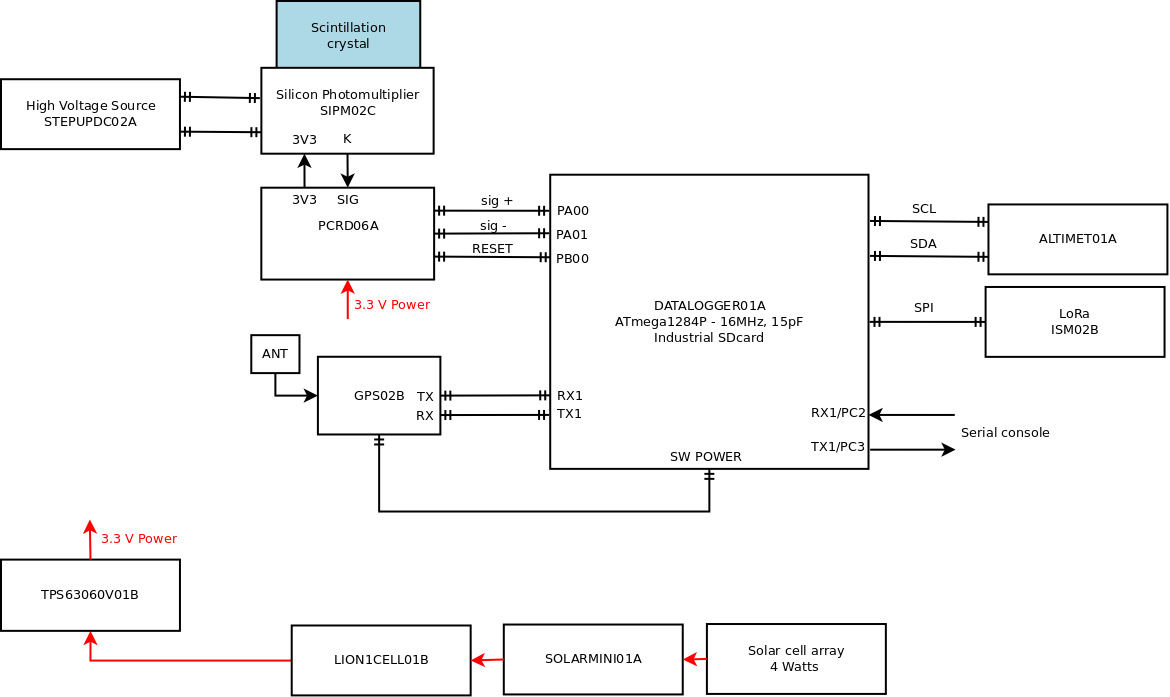Open-source scintillation detector of ionizing radiation. The device can be further modified according to specific requirements. The character of its construction makes it especially suitable for placement into mountains for in-field measurements
If you need a fully automatic ionizing radiation dosimeter-spectrometer device (with internal logging and a backup power supply) or a device designed for outdoor use without the possibility of connecting to a power supply and data network GEODOS01 might be a better option. We can help you in choosing the most suitable device or even design and develop a new one according to your requirements. In either case, reach us using email support@ust.cz.
GEODOS devices are mounted in multiple significant locations around Europe at this moment.
One GEODOS device is installed in Chernobyl Red Forest site.
GEODOS devices are installed in multiple locations in Šumava. For example example at Polednik watch tower.
The National Atmospheric Observatory Košetice (NAOK) was established by the Czech Hydrometeorological Institute as a department specialized in long-term air quality monitoring and research at the background scale in 1988. The GEODOS is located here by CRREAT project.
- Detection element: scintillation crystal NaI(Tl) 14 mm in diameter, 20 mm in length, integrated with SiPM detector
- Power source: solar panel
- Backup power source: LTO cells
- Data memory: SD card
- Record’s content: energy and time of each event above the specified energy (1MeV by default)
- Record’s periodicity: 10 s (maximal dead time 2 s)
- Time resolution: 20 us
- ADC Conversion time: 104 us
- Dead time: 2 us
- Accuracy of event’s time: 500 ns
- Energy range: 0.3 to 18 MeV (deposited energy)
- Spectral Resolution: 0.02 MeV
- Open-source HW and SW
- Device status indicator type: LED
- Uninterrupted measurement campaign interval: 6 months for 2 GB SD card
- LoRa connection to IoT network
- Charging temperature range: -20°C to +35°C
- Operational temperature range: -30°C to +50°C
- Dimensions 254x180x111 mm enclosure TK PS 2518-11-o
- Weather protection IP 33
The core of the detector is a scintillation crystal with SiPM detector.
The primary raw data is stored in the SD card's memory. The IoT network is used for telemetry data transfer, and device monitoring (e.g. temperature, humidity, pressure, battery voltage, etc.). We are regularly using the TTN, but the device could be configured for use with any IoT LoRa-based network. For remote areas, mounting an IoT gateway in the radio range of GEODOS instruments could also be a good option.
As a second message, when turned on, a string is sent that uniquely identifies the device.
$DOS,GEODOS01B,L02,256,379276a,1290c00806a200914056a000a0000086
$DOS- is the first character of the message stringGEODOS01B- Name of the device. In this case, it is GEODOSL02- FW version256- ADC offset379276a- Hash of commit with this firmware1290c00806a200914056a000a0000086- Unique serial number of dosemeter instrument
The output data are in the form of textual NMEA-0183 like strings. There are two main message types - Histogram message ($HIST) and events stream message ($HITS). Both of these messages could be combined in data output from a single device.
$HIST,8,118.15,960.09,4.06,2.33,394,803,0,3,30656,2401,1304,5,3,4,7,9,5,4,6,7,4,3,0,8,2,3,1,1,1,4,3
$HIST- Marking a message with spectrumscount- Message number since restart or power-uptime- Time in seconds from power-upsuppress-dose- Number of detected particlesoffset- ADC offset. Specifies the zero channel position.energetic channels- All remaining values indicate a certain energy channel. From the smallest to the largest. The third value is 1st channel.
$HITS,20,916,84,2984,37,16386,38,30666,26,38530,48,43043,27,49257,100,53904,43,59650,32,65631,32,65802,46,68555,47,71124,53,73601,48,74179,59,77454,72,90563,30,98074,74,98901,124,99743,50
$HITS- Marking a message with individual eventshit count- Number of events captured from the last HITS messagetime- Time in seconds from power-uphit channel- Channel corresponding to the captured event
- STEPUPDC02A
- SIPM02C known as "AIRDOSC01A_PCB01C"
- PCRD06A
- GPS01B
- DATALOGGER01A
- ALTIMET01A
- ISM02B
- TPS63060V01A
- LION1CELL01B
- SOLARMINIBAT01A
- SOLARMINI01B






